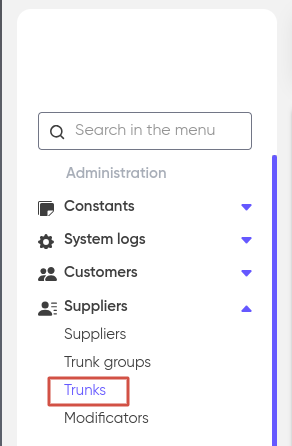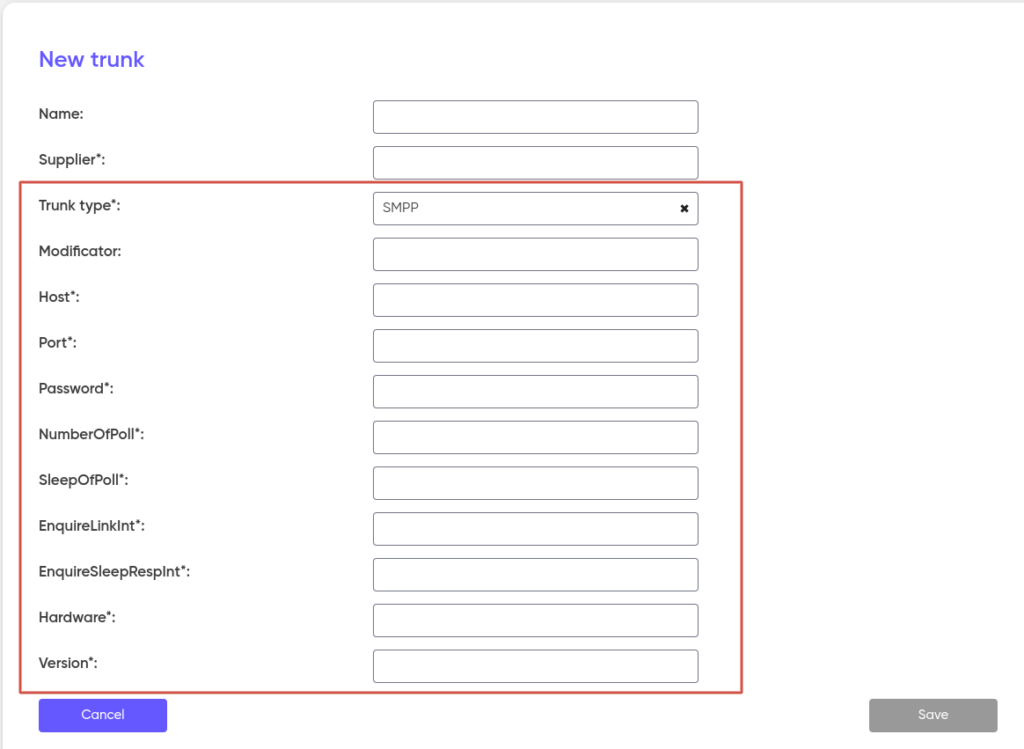Trunks
Traffic to the Supplier is impossible without establishing a physical Trunk connection.
Trunks are created and stored in the “Trunks” section and are always linked to a specific Supplier.

It is possible to create any number of trunks with different types and settings for any Supplier.

When creating a trunk, the following information is required:
- Name (can be specified arbitrarily). In the case of creating a trunk for telephony, the name should be specified as follows:
- Trunk with registration: SIP/login;
- Trunk without registration: SIP/(name in Latin) (any arbitrary but unique name);
- Provider (select a specific provider to which the trunk is connected);
- Trunk type (determined by the traffic transmission protocol);
- Modifier (specified if the outgoing traffic transmitted through the trunk requires preliminary transformation).

The type of trunk is determined by the protocol over which the traffic is transmitted. Each trunk type has a characteristic set of settings, in the form of fields that appear in the trunk creation form after selecting the trunk type.

SMPP protocol:
| Setting | Description |
|---|---|
| Host | SMPP server address |
| Port | SMPP server port |
| Password | SMPP server password |
| NumberOfPoll | number of survey attempts |
| SleepOfPoll | the time interval (in milliseconds or seconds) between server polling attempts |
| EnquireLinkInt | the time interval (in milliseconds or seconds) through which the client will send Enquire Link packets to verify the connection to the server |
| EnquireSleepRespInt | the time interval (in milliseconds or seconds) for waiting for a response from the server to the Enquire Link packet |
| Equipment | SMPP server hardware |
| Version | the version of the SMPP protocol used |
HTTP protocol:
| Setting | Description |
|---|---|
| Url | The URL of the server to be interacted with |
| CallbackUrl | The URL to which callbacks from the server will be sent |
| Version | API version used — indicates the version of the API that is being used in the current context; API version in the URL — indicates the version of the API as part of the URL. |
SIP protocol:
| Setting | Description |
|---|---|
| Host | server address |
| Port | server port |
| Context | context for SIP connections |
| CallLimit | limit on the number of calls |
| CpsLimit | limit on the number of calls per second |
| Sip Connection direction | SIP connection direction (input, output, two-way) |
| Equipment | type or model of equipment |
| Logging on SBC: | logging on the Session Border Controller (SBC) |
| Type of SIP authentication | authentication type for SIP connections |
| Area ID | the ID of the zone or region used for routing calls or other logic |
| Interface name | the name of the network interface used for SIP connections |
| Sending SIP OPTIONS, ms | the time interval (in milliseconds) for sending SIP OPTIONS requests in order to check the availability and connection status |
PUSH ID MTS protocol and PUSH ID Beeline protocol:
On this page